(You can skip this part and just look at the code.) I'm creating a complicated form. The form creates, say, a Post object, but I want to be able to create several Comment objects at the same time. So I have a Post form and a Comment form. In my Post form, I can fill out the title, description, etc., and I can add several Comment forms as I create more comments. Each form has an @ObservedObject viewModel of its own type. So I have one parent Post @ObservedObject viewModel, and another @ObservedObject viewModel for the array of the Comment objects which is also a @ObservedObject viewModel.
I hope that made some sense -- here is code to minimally reproduce the issue (unrelated to Posts/Comments). The objective is to make the count of the "Childish" viewModels at the parent level count up like how they count up for the "Child" view.
import Combine
import SwiftUI
final class ParentScreenViewModel: ObservableObject {
@Published var childScreenViewModel = ChildScreenViewModel()
}
struct ParentScreen: View {
@StateObject private var viewModel = ParentScreenViewModel()
var body: some View {
Form {
NavigationLink(destination: ChildScreen(viewModel: viewModel.childScreenViewModel)) {
Text("ChildishVMs")
Spacer()
Text("\(viewModel.childScreenViewModel.myViewModelArray.count)") // FIXME: this count is never updated
}
}
}
}
struct ParentScreen_Previews: PreviewProvider {
static var previews: some View {
ParentScreen()
}
}
// MARK: - ChildScreenViewModel
final class ChildScreenViewModel: ObservableObject {
@Published var myViewModelArray: [ChildishViewModel] = []
func appendAnObservedObject() {
objectWillChange.send() // FIXME: does not work
myViewModelArray.append(ChildishViewModel())
}
}
struct ChildScreen: View {
@ObservedObject private var viewModel: ChildScreenViewModel
init(viewModel: ChildScreenViewModel = ChildScreenViewModel()) {
self.viewModel = viewModel
}
var body: some View {
Button {
viewModel.appendAnObservedObject()
} label: {
Text("Append a ChildishVM (current num: \(viewModel.myViewModelArray.count))")
}
}
}
struct ChildScreen_Previews: PreviewProvider {
static var previews: some View {
ChildScreen()
}
}
final class ChildishViewModel: ObservableObject {
@Published var myProperty = "hey!"
}
I can't run this in previews either -- seems to need to be run in the simulator. There are lots of questions similar to this one but not quite like it (e.g. the common answer of manually subscribing to the child's changes using Combine does not work). Would using @EnvironmentObject help somehow? Thanks!

